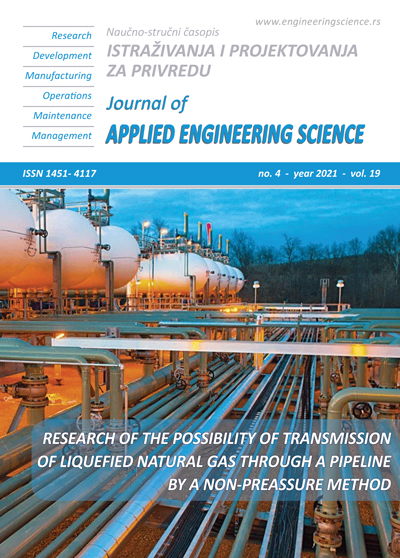THE PROCESS OF MONITORING THE CURRENT CONDITION OF OIL RECOVERY AT THE PRODUCTION FIELDS IN WESTERN KAZAKHSTAN
Abstract
This paper discusses topical problems of further effective development of depleted oil fields (DOF) to increase their final oil recovery on the example of the oil field in Western Kazakhstan. Further exploitation of fields using waterflooding becomes unprofitable. At the same time, on average at these facilities, at least 50% of the reserves will remain unrecovered. Most of the oil fields in the Republic of Kazakhstan are at the late and final stages of development, which is characterised by an increase in the share of hard-to-recover oil reserves, a decrease in annual oil withdrawals, and a high water cut of the produced oil. Therefore, the problems of improving the technology aimed at reducing the volume of associated water production and increasing oil recovery from partially flooded deposits is very urgent. With an increase in the well density, the degree of field drilling and aging of the well stock, the work with the current declining well stock remains a very topical issue. Improving the efficiency of diagnostics and the systematic selection of wells for repair and isolation works is an important element for rationalising field development in the current conditions of profit variance in the oil and gas industry. The methods of bottomhole zone treatment also implement a deflecting effect on filtration flows. Therefore, this method includes a wide range of geological and technical measures: down-spacing; water production restraining; conformance control of injectivity profiles; forced production; all types of mechanical, thermochemical and thermal technologies. Consider a number of geological and technical measures that perform the tasks of occupational safety rules. Geological and statistical models are proposed for diagnosing wells for a premature increase of water production using factor analysis calculations for base production and Hall plots. Results. The degree of temperature influence of the primary components of the compounds on the rheology, filtration characteristics, and stability of inverted emulsions was determined. The classification of oil loss factors was carried out based on the results of downhole analysis and oil production losses were determined. Geological and statistical models for well diagnostics for premature increase in water production were built using factor analysis calculations for base production and Hall plots.
References
2. Amelin, I. D., Davydov, A. V., Lebedinets, N. P. 1991. Analysis of the development of oil deposits in fractured reservoirs. Moscow: CMEA. 152 p.
3. Amelin, I. D., Subbotina, E. V. 1986. Features of the development of oil deposits with carbonate reservoirs. Oilfield business: overview information, 8 (115), 45.
4. Amelin, I.D., Andriasov, R.S., Gimatudinov, Sh.K. 1978. Operation and technology for the development of oil and gas fields. Moscow: Nedra.
5. Amelin, I.D., Surguchev, M.L., Davydov, A.V. 1994. The forecast for the development of a late stage oil reservoir. Moscow: Nedra. 308 s.
6. Azga, X., & Settari, E. 1982. Mathematical Modeling of Reservoir Systems. Moscow: Nedra. 407 p.
7. Bagrintseva, K.I. 1982. Fissured sedimentary rocks. Moscow: Nedra. 256 p.
8. Balakin, V.V., Vlasov, S.A., & Fomin, A.V. 1998. Modeling polymer flooding of a layered heterogeneous reservoir. Oil Industry, 1, 47-48.
9. Chusteev, R.V. 2017. Influence of flow diverting technologies on water cut of oil wells in the Vankor field. Krasnoyarsk: Siberian Federal University
10. Delamaide, E. 2014. Polymer flooding of heavy oil – from screening to full-filed extension. https://www.onepetro.org/conference-paper/SPE-171105-MS
11. Delamaide, E., Zaitoun, A., Renard, G., & Tabary, R. 2013. Pelican lake field: first successful application of polymer flooding in heavy oil reservoir. Society of Petroleum Engineers, 17(3). https://www.onepetro.org/journal-paper/SPE-165234-PA
12. Dubinsky, G.S., Andreev, V.E., Akchurin, Kh.I., & Kotenev, Yu.A. 2012. Development of technologies for limiting water inflow into production wells. Georesources, Geoenergy, Geopolitics, 1 (5), 25-36.
13. Fattakhov, I. G., Kadyrov, R.R., Galushka A.S. 2014. Isolation of water production in wells through the use of gel-forming compositions. Contemporary Problems of Science and Education. https://www.science-education.ru/ru/article/view?id=16995
14. Kang, X., & Zhang, J. 2013. Offshore heavy oil polymer flooding test in JZW area. Society of Petroleum Engineers – SPE Heavy Oil Conference Canada 2013, 2, 1127-1134.
15. Manichand, R., Mogollón, J.L., Bergwijn, S., Graanoogst, F., Ramdajal, R. 2010. Preliminary assessment of Tambaredjo heavy oilfield polymer flooding pilot test. SPE Latin American and Caribbean Petroleum Engineering Conference Proceedings, 1, 548-561.
16. Moe Soe Let, K.P., Manichand, R.N., & Seright, R.S. 2012. Polymer flooding a ~500-cp oil. SPE – DOE Improved Oil Recovery Symposium Proceedings, 2, 1670-1682.
17. Sheng, J.J., Leonhardt, B., & Azri, N. 2015. Status of polymer-flooding technology. Journal of Canadian Petroleum Technology, 54(2), 116-126.
18. Walcott, D. 2001. Applied Waterflood Field Development. Moscow: YUKOS. 144 p.
19. Wassmuth, F.R., Green, K., Hodgins, L., & Turta, A.T. 2007. Polymer flood technology for heavy oil recovery. Canadian International Petroleum Conference 2007, CIPC 2007. https://www.onepetro.org/conference-paper/PETSOC-2007-182
20. Zhou, W., Zhang, J., Han, M., Xiang, W., Feng, G., Jiang, W., Sun, F., Zhou, S., Guo, Y., & Ye, Z. 2007. Application of hydrophobically associating water-soluble polymer for polymer flooding in China offshore heavy oilfield. International Petroleum Technology Conference 2007, 3, 1449-1453.

